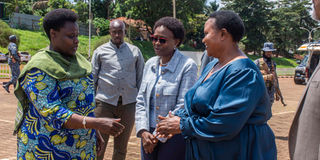Govt launches self-testing initiative to curb HIV/Aids

Minister in Charge of the Presidency Milly Babalanda (right), and the Health minister, Dr Jane Aceng (centre), welcome Vice President Jessica Alupo (left) at Kololo Ceremonial Grounds yesterday. PHOTO/ ISAAC KASAMANI
What you need to know:
The Health ministry wants to end HIV/Aids as a public health threat by 2030
The government has said it’s targeting more than five million Ugandans in the new HIV self-testing drive launched yesterday in Kampala.
Speaking at the launch of the Community CheckNow HIV self-testing services, Vice President Jessica Alupo said it is one of the strategies the government is using to end HIV/Aids as a public health threat by 2030.
“By making testing more accessible, and reducing the stigma associated with it, the goal is that more people will be encouraged to know their status and take the necessary steps to protect their health and the health of the community,” she said.
The vice president also observed that although there’s significant progress in the HIV/Aids fight, the numbers of new HIV infections and Aids-related deaths being registered in the country annually, are unacceptably high.
“We currently have around five percent of the population living with HIV/Aids, which is a better position than where we were in the 1990s when the proportion of all people living with HIV/Aids in the country was estimated at 18 percent,” she said.
She added that the “numbers of new HIV infections and Aids-related deaths are still high. There are still underutilised opportunities to bring these numbers further down” .
According to statistics from the Uganda Aids Commission, every year, the country registers over 50,000 new cases of HIV infections with about 17,000 annual Aids-related deaths.
Dr Jane Ruth Aceng, the Health minister, said the CheckNow HIV self-test kits have been in the country for two years and that validation tests at the Uganda Virus Research Institute confirmed that the kits produce quality and reliable HIV test results.
She said the launch followed a pilot study they conducted to determine the acceptability and willingness of the users to report.
“Remember, it is not just about testing yourself. It is testing yourself and reporting to the nearest health facility, whether you’re negative or positive. So this launch today is to alert the entire nation that the test kits are available. And they will be available for the five million shy people,” she said.
Dr Aceng added:“The youth, especially adolescent girls and young women, the men, the key populations, they are free to access the test kits. They are available in the facilities. They will be provided to you free of charge. And their rollout to all the communities will be through the Village Health Teams because they are not going to be facility-based.”
The kits are made by Abbott Laboratories, an American multinational medical devices and healthcare company with headquarters in Illinois.
Information from Abbott indicates that the clinical evaluations of kits showed that they can “correctly identify 100 percent (600 out of 600) of HIV positive samples (known as test’s sensitivity)” with a confidence interval of 99.5 percent to 100 percent.
The vice president said these kits can give accurate results, but there’s a need to “emphasise that the main mode of HIV transmission is through sexual contact with the infected person”.
“Therefore, the answer to prevention of HIV/Aids still lies in Aids awareness through sensitisation of the population with particular emphasis on behaviour change,” Ms Alupo said.
How it works
According to Abbott, the CheckNO HIV self-test is designed to detect the presence of antibodies to both HIV-1 and HIV-2 in blood samples within 15 minutes.
It consists of a test device and a buffer solution.
To use the test, two drops of blood are collected from a fingerstick and placed in the basin of the plastic cover.
One drop of blood is then transferred to the well on the test device, followed by the application of one drop of buffer. Upon completion of the test, two lines may appear on the device: a red line in the Control Line (C) area, indicating proper sample application, and a red line in the Test Line (T) area, indicating the presence of HIV antibodies in the sample.




